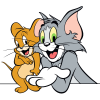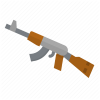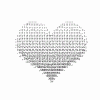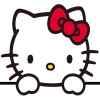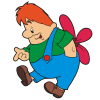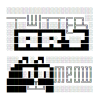Future Potentials for ASCII art
1 Introduction
In his book Gramophone, Film, Typewriter Friedrich Kittler identifies the typewriter as the symbolic medium par excellence (Kittler 1986:15). With a highly limited set of characters, humans have managed to formulate grand texts to symbolize laws, religions, politics and myths. But the material characteristics are normally invisible to us. This is why the typewriter can be considered as a key symbolic medium. It paved the way for the computer keyboard which at the moment, using the Unicode standard, supports up to 110,000 characters.
Text characters have been used for visual art for thousands of years, and seems to be gaining momentum. One reason is that digital media, by virtue of programming languages and protocols, is tightly connected to the text characters of e.g. ASCII and Unicode. Studying the foundations of digital media, often indirectly means to study flows of text characters - just like in the Matrix, according to some. Another reason is what Reynolds (2011) calls retromania, the large-scale cultural development that re-approaches previously popular forms of expressions in order to explore "new” options.
2 Brief History
Before typewriters and computers, calligrams were likely the most common form of text art. A calligram is an image built with words or text characters that relate to the content. Simmias of Rhodes’ Axe (325 B.C) is one early example. Micrography is a Jewish form of calligraphy, which is said to be a method to bypass the restrictions on images as expressed in the Second commandment. Muslims also used text art to represent religious ideas. The square kufic scripts appear as a mixture of QR-codes and ASCII art already in the 13th century. In some examples of printed texts, illustrations were also created through the careful organization of typographic ornaments.
The typewriter disseminated text art to a broader public. A secretary by the name of Flora Stacey made a famous picture of a butterfly in the 1890s, by moving the paper in the typewriter while typing. People such as Julian Nelson and Alan Riddell popularized this technique for hobbyists as well as artists and poets. Sylvester Houédard was a priest and concrete poet who used typewriters to make abstract art. Like Contemplation (1972) shows many abstract shapes, which gives little indication of being made with a typewriter.
In 1921 Marcel Duchamp and Man Ray produced the magazine New York Dada, well known for its cover which displayed a small readymade collage surrounded entirely by the typewriter generated words New York Dada backwards. In this example the words become a pattern and incantation that reinforces dada aesthetics (Ades 2006:146,158). Theo Van Doesburg, more likely known for his paintings and contribution to De Stijl, created the visual design for the four-issue dada-constructivist magazine Mecano. Each issue included the name of the magazine as a text-diagram and presented a direct relationship between the the type characters, the image design they created, in addition to being conceptually significant (Ades 2006:261,270). Dada artists’ interest in the use of language perhaps created a unique avenue for experimentation with printed text that was visual, verbal, conceptual, and sometimes political.
Concrete poetry functions by placing equivalent importance on the form that the typographical characters are given and their semantic meanings. An early and popular example of this is Guillaume Apollinaire’s Il Pleut (1913-1916) where the meaning of the text is enhanced by its diagonal and linear presentation. This approach was also employed by many artist/poets, such as bpNichol. Other Literary movements, including Oulipo, experimented with language and text using algorithmic methods like Raymond Queneau’s Cent Mille Milliards de Poèmes (1961) in which the fourteen lines of ten sonnets are interchangeable. The configuration of the printed text is based on how the reader interacts with it. These examples demonstrate the interest of artists and poets in how we interpret the printed word based on its presentation and design. There is the potential for meanings to be generated through the visual organization of the text and the language used that can reinforce each other as well as become conceptual investigations. In his historical analysis of pre-1900s visual texts, Pattern Poetry, Dick Higgins refers to this relationship as the "synthesis of visual and literary experience” (Higgins 1987:3).
2.1 From Teletype to ASCII: Textmode
While typewriter art allows the user to position text characters arbitrarily by moving the paper, ASCII art traditionally works in so called textmode. A textmode screen is a grid of equally sized cells, where each cell can contain one text character. It uses a monospace typeface, meaning that all the characters receive exactly the same amount of space, so that every line or inch has the same amount of characters. The number of characters per line usually varies between 32 and 80, depending on the platform. Modern text inputs use a variable-width typeface, which is not possible in textmode. As such, textmode graphics can be described as a form of mosaic that uses a strict grid and a set of typographic symbols. An important aesthetic precedent can be found in the rationalization and atomization of visual communication in the 1920s - both among artists and marketers (Manovich 1993:11). Later on, pattern artists such as Peter Struycken or Dominique Douat would generate early computer graphics with similar ideas, also connecting to the 18th century works of Sebastian Truchet.
It is also worth mentioning tile-based graphics, common in videogames in the 1980s. In order to save resources, graphics were constructed from a set of tiles, similar to a font but often using more colours and pixels. People like NoteNdo who hack old game consoles therefore often end up with a mosaic aesthetics similar to textmode. The similarity comes from the consistent grid that is used to either display graphic tiles or fixed-width type characters.
Teletype, which appeared around 1850, was the first telematic medium for text communication (Royal Earl House and David Edward Hughes introduced keyboard-based telecommunications 1844-1857). It was similar to morse telegraphy in converting text characters into sounds, but it used typewriters and printers as interfaces. The oldest preserved teletype graphics are from the 1960s, but the practice is most likely much older than that. In order to standardize the communication, teletype focused on the Baudot code which predated the ASCII-standard by almost 100 years.
ASCII appeared in the 1960s as a way to simplify communication between computers. This was the same decade as the first computer art exhibitions took place. There were computer artists/engineers who worked with similar methods to ASCII art. Ken Knowlton and Leon Harmon exhibited a textmode version of a nude at the MOMA in New York in 1968. By calculating the brightness of each text character using a computer, they converted a photograph into a mosaic-like textmode picture. It is the same technique used by e.g ASCIImeo.com and the VLC media player, to convert video into ASCII animations.
2.2 Replicating the Pixel
At the end of the 1970s, text art was popularized through two digital media: computer games and teletext. Early computers like PET, TRS80 and ZX81 were usually better at using text rather than pixels, which made them suitable for text adventures (interactive fiction). The character sets of the computers had symbols that were well-suited for graphics. Several platforms added symbols that enabled a technique similar to pixel graphics. Larger custom texts and images could be generated by combining symbols that represented different portions of text characters. One ‘pixel’ was one section of a text character.
Teletext worked in a similar way. It was a TV-service with text-based information sent in parallel with the standard TV-signal, originally intended for subtitles. The graphics were completely text-based, built with a graphics-friendly character set which was also used in home computers such as ABC80 and MicroBee. The teletext standard was also used for videotex, which was a modem-based precursor to Internet that allowed for two-way communication. In France, this service was in use until 2012 (examples can be found here).
2.3 Networked Communications
Around the same time, the home computer revolution brought with it a modem-connected network of Bulletin Board Systems (BBS). Along with e.g videotex, they were the social networking sites of the 1980s and 1990s where users exchanged messages and software. The interfaces were completely textbased, which created a demand for high-quality ASCII menus and logos. In the early 1990s, these graphics started to appear as separate artefacts, known as ascii collections or art packs (Polgár 2005:121). It used a rather distinct mixture of graffiti, leetspeak poetry and pixel art aesthetics. This ASCII art style is still mostly seen in hacker contexts on FTP-sites, IRC and in info files for cracked software.
ASCII art became very popular in the demoscene, which is a subculture dedicated to audiovisual hacking that at the time depended on BBSs for quick distribution. They frequently work under very restricted conditions, such as making a "music video” using only 1 kilobyte, and would therefore often use textmode graphics together with chipmusic. Also known as chiptune, this genre uses digital waveforms found in the soundchips of old computers and consoles, much like text graphics uses the fonts of these systems. Since there are both technical and cultural connections between the two, chipmusic and ASCII art frequently appear together in demos, crackintros and keygens (programs that generate software license codes).
On the Internet, ASCII art most likely reached its high point of importance before it was available to the general public in the early 1990s. At that time it was distributed mostly through e-mail listservs and BBSs (Danet 2001:208). Connection speeds were slow by today’s standards and transferring the smaller size text files was done much more quickly than a traditional image file. Later, a new form of ASCII appeared which doubled the amount of available characters. These new characters, along with ANSI escape codes that enabled the use of colours, created a new generation of ASCII art that is usually referred to as ANSI art (see Hargadon 2011). A number of Usenet newsgroups developed and further distributed ASCII art.
The World Wide Web allowed for access to ASCII art in a different way. Originally, those involved in newsgroups and listservs made their work available to others in their groups through FTP sites. Files had to be transferred and then viewed offline. The web enabled artists to show text graphics in online "galleries”. The work could be seen on the site and copied or downloaded as needed. In addition, it became easier for artists to share technical information about their process. ASCII art images and FAQ files were combined into large collections and website databases allowing for the accessibility that has made them now ubiquitous.
In the art world, text-based network media were normally used more for words than images. Exhibitions such as Interplay (1979) and La Plissure Du Text (1983) experimented with networked storytelling in a similar way to some mail art, but in real-time. In 1997 Steve Deitz began directing Gallery 9, one of the first specifically digital collections housed within a more traditional contemporary art museum, the Walker Art Center and included works like Mark Amerika’s PHON:E:ME. Hypertext and experimental electronic text more commonly fall within the digital humanities, since they are generally more concerned with semantic meanings than visual appearance (see ELO). It is also worth noting the practice of generating larger letters and fonts, such as the FIGlet collection (here and here), out of smaller ones.
One of the more widely known ASCII artists is Joan Stark whose collection carries a wide range of works, most of which include her signature ‘jgs’. Her site is still hosted by one of the earliest free web hosting services Geocities. It is a good example of a common format for sites focused on ASCII art in that it includes a collection of ASCII images as well as information about the history of the form, FAQ, tutorials, and links to other ASCII collections. Stark’s work is largely done ‘by hand’, meaning that the artist created the images by typing in text editing software. This relates directly the tradition of typewriter art within a textmode grid while other opportunities exist that use software to convert images into their text equivalent. Because of Stark’s method, the images have an elegant and engaging simplicity of form. Browsing her site reveals the reason she is commonly referred to as the ‘Queen of ASCII art’.
2.4 Internet Art uses of ASCII
Loading the website of the artist duo Jodi (Joan Heemskerk and Dirk Paesmans) creates something that reads like a glitch - it appears as gibberish, as if the site creators didn’t debug the page. It is an underscored, center-aligned block of neon green text, unreadable and incomprehensible. A casual observer today might still read the page as if it was simply a mistake. It is as if the page that has loaded is nothing more than random configuration of text characters. Behind this assumed mistake, in the source code, we find something much more meaningful. The potential that is explored with this work is held between the code and display levels of the browser. It exploits the fact the code level whitespace is ignored when the web browser renders the page. Jodi’s source code shows us ASCII art diagrams. The page is a bomb and we see the aftermath within the browser window and the bomb itself in the source code. The ASCII art is hidden away from view and we see the text characters unformatted where we typically expect to see something legible (Greene, p. 41).
The approach to ASCII employed by Jodi is typical of the way that artists working on the early Internet adopted and used existing media for creative and conceptual experimentation. At the core of their approach was the realization that within the machine, a computer, the meaning held in language is not necessarily interpreted, it is processed. All text and images that are displayed are converted through standards like ASCII into a format that is more easily understood and processed by the computer. The use of ASCII in early Internet Art was a way of revealing what is going on within the machine and perhaps a way of making it aesthetic. Vuk Cosic’s Deep ASCII (1998) demonstrates this by exploring the relationships between the porno and game industries by developing a method to display video images with ASCII on a Pong game console. The graphic simplicity of green text on a black screen, although unnecessary in the late 1990s, reinforced the aesthetic quality and history of writing code - a language meant to be interpreted by a machine but instead displaying one of the most recognizable pornographic films as a sort of visual raw data. The site ASCII Rock (2003) by C505 (Yoshi Sodeoka) combines ASCII art video processing of popular rock music videos accompanied by General MIDI music.
In these examples, ASCII art moves away from the line-based aesthetics of e.g. Joan Stark in order to explore the conceptual relationship between text-as-code and text-as-image. Stark’s ASCII is a form of manual craft made by hand, where the success of the work lies in a correct remediation, or stylish interpretation. With Jodi, Cosic, and Sodeoka that translation is automatized and less significant. What matters is what has been translated, and why. Both types of work maintain references to the subject and are therefore still representative. However, with the more conceptual ASCII work, our attention is drawn towards how computational processing relates to human language and visual perception.
3 Terminology and Categories
ASCII, Morse code and Unicode are character encoding systems (also known as character sets) that assigns numbers to every symbol. The symbols are letters, numbers and cultural glyphs like arrows and squares, but there are also non-visible control characters such as tab, return and clear screen. These control characters date back to Baudot and Morse codes (for example, BEL is a code that usually makes a warning sound which originates in the Baudot code). The characters can look different depending on which typeface is used and what size it has, and the characters can be positioned in a textmode grid or more arbitrarily. The appearance of ASCII art can also change according to the screen used. For example, an old cathode-ray screen can be important for the experience of the graphics, as Ian Bogost argued with the television simulator. From this it is possible to define several different levels to discuss ASCII art.
Symbols → Character Encoding → Typeface → Typography → Screen → Perception
ASCII originally referred to a standard from the 1960s which encoded 95 printable characters, but the meaning of the term has shifted over time (ASCII contains a total of 128 characters, but 33 of them are control characters which are used to affect how text and space is processed. The original meaning of the term ASCII is today known as US-ASCII). Today, the term ASCII normally refers to any text-based expression, regardless of the character encoding system used. For example, text-based art online is called ASCII although it most likely uses Unicode. The term ASCII art is used accordingly in this text; as an umbrella term for any text-based art that uses a preset font in textmode. As such, we consider ASCII art as a genre which consists of several categories. Some of those categories are direct consequences of the platforms used, such as PETSCII (early Commodore computers) and ATASCII (8-bit Atari computers). These terms refer to both the character encoding and typeface. Shift_JIS is a similar term, used in the west to describe Japanese text art (in Japan usually called AA, short for Ascii Art). Technically, Shift_JIS is a group of character encoding systems for Japanese characters. They are used with various typefaces - both monospace and variable - and are not fully compatible, which has made Unicode encoding more popular in recent years.
Amiga ASCII uses a 7-bit character encoding and has a particular style due to fonts like Topaz and P0TN0oDLE which made it possible to make continuous lines with /-signs. Therefore, skewed logotypes are more popular here than in other ASCII art. In the early 1990s, dedicated ASCII art groups started to release collections of their work, which can be viewed online with the right encoding and fonts at asciiarena.com.
Block ASCII is the informal name given to a standard developed by IBM in the late 1970s. It was an 8-bit character set which contained several characters that enabled a pixel-based approach to ASCII art. Block ASCII is essentially a black and white form of ANSI art, and it was very popular among MS DOS users, particularly in the "warez scene” (see Rehn 2001).
ANSI art uses 8-bit encoding and offers 16 predefined colours. It is arguably the ASCII art that is most similar to pixel graphics. The combination of Block ASCII characters and colours creates an appearance similar to pixel graphics and some characters that mimic dithering. The underground community of artists that work with ANSI is often called The Art Scene, and they release art packs.
With each of these styles of ASCII art, it is easy to see the relationship between the text characters used and the way in which pixels were eventually used for graphical display. The different styles reproduce the concept of pixels in different ways because of the different character sets they utilize. For example, something created in a Block ASCII style might use something like a ‘dark shaded block character’ ▓ and is visually similar to the PETSCII character ▒.
4 Non-representative ASCII
It is a natural tendency for images to be recognizable and interpreted easily. For ASCII art this means that the visual experience outweighs the verbal connotations of text. In some cases the text used is significant because it reinforces the purpose or meaning of the image created as in concrete poetry. ASCII art is normally successful when it renders correctly, it is decoded properly, the communication is received successfully - as with most media art. But ASCII art can move beyond its traditional functions and expand while still carrying its aesthetic significance.
Text-based visual art is commonly not meant to be executed or interpreted as in software and language. It could become simply a visual language on a screen made up of both code and image marks to be interpreted by the viewer. This works on the basis of imagination and recognition: that the code is not code in the typical sense but is preformatted to generate an image or graphic. It works in an avenue between writing and drawing; not explicitly one or the other but with aspects of both. It is decoded by the viewer as with the tradition of other image forms like painting or drawing. The marks are decoded and an image constructed individually by the viewer. The potential for non-representational ASCII art begins to form around the consideration of the textmode characters as marks on a digital surface.
The ASCII character set is a limitation unique to digital environments and in contemporary uses of computers it is somewhat arbitrary. In most cases, it is irrelevant to know or understand the character set because it happens ‘behind the scenes’. However, this characteristic is what ties together experimental literature forms like concrete poetry and Oulipo with the conceptual aesthetics of early Internet artists. The constraints placed on visual display by a deliberately chosen set of text characters opens the potential for a digital aesthetic that speaks about how humans use language different than machines. It is perhaps a visual language somewhere between them that creates avenues for new meanings to be generated. With this understanding, the ASCII character set becomes like a digital mark-making tool that could be used as a more complete analog to drawing or painting than software remediations of brushes or pencils. As the typewriter and letterpress opened up room for experimentation with text as image, so does the keyboard.
One of the major characteristics of new media identified by Lev Manovich is that of modularity (Manovich 2001:30). In the context of ASCII as a standard, the individual text characters are modular and portable between almost any software application. In addition, entire ASCII art compositions are modular and can be copy/pasted intact from one document to another or from application to application without changing the fundamental text nature of the composition. For example, one could copy a drawing directly from Joan Stark’s site, paste it into a text document and edit, then copy the edited version into animation software and create a moving typographic sequence. At each stage of that process the drawing is a modular unit that functions across software applications or operating systems. It is a modular structure within a textmode grid.
4.1 Current Tendencies
ASCII art websites still exist and their communities thrive (Some examples include utf8art.com in Japan, ansiart.org in China, asciiarena.com in Europe and asciimator.net). In addition, new uses of the format have been taking form on other Internet-based platforms. Under the hashtags #TWITTERART, #140art, and #sYmBoLaRt, a range of users draw within the 140 character constraint of Twitter. The posts under this tag include type graphics, cartoons, drawings, and simple patterns. The works crashtxt and reCAPCHAT by jimpunk use Twitter to different conceptual ends. The former presents the viewer with a web-based Unicode keyboard and processes the input directly into the crashtxt Twitter. The latter asks users to use a traditional ‘captcha’ form and posts to the reCAPCHAT Twitter. These works share the modularity of ASCII art but not its traditional, pre-Unicode aesthetics. Our attention is turned to the way we see and interpret textmode characters on the web.
Other artists use the characteristics of social networking sites as an invitation to look for and exploit bugs with aesthetic intent. The Facebook account glitchr run by Laimonas Zakas, has been known to break outside of the normal formatting and layout of the networking site. Posting status updates made up entirely of obscure Unicode characters and diacritical marks, glitchr’s feed was made up of floating marks over, around, behind, and on top of other page content. The posts, in essence, broke or hacked the Facebook layout and transformed it into a place where text characters were "emptied from their primary communicative signifiers and repurposed as formalized, aestheticized objects”. Screenshot documentation of the Facebook account and Tumblr eventually served as a way to preserve the posts as the websites fixed the bugs glitchr exploited. What became visually challenging and aesthetic was the breakdown of the tightly designed site called forth through the insertion of a form of ASCII art where normally one might find banal text.
Daniel Temkin’s work Unicode Frenzy randomly chooses Unicode characters and organizes them into multi-layered designs. Like glitchr’s broken Facebook displays, Temkin’s Unicode layouts turn our attention to the aesthetics of individual text characters and how they are arranged in web display. Disregarding the type grid and the preformatted nature of traditional ASCII art, their work generates a visual aesthetic from broken language. A more simplified way of viewing this breakdown might come from another project of Temkin’s, Unichar, which creates a sort of ‘Hot or Not’ for the Unicode character set.
5 Conclusion
The relevance of ASCII art falls within its unique position in between human language, programming language or code, and visually aesthetic language or image. Its potential, however, lies in our ability to use ASCII as a way to blur those boundaries. When text characters are used independently from their function as language and when images are generated with no representational reference, then text characters become their own modular visual units. Those units might maintain their other significances, but can also generate new meanings.
These potentials are already explored by artists, but will likely spread to other fields. With the popularity and power of text-based media such as Google Search, Twitter and Facebook Ads comes new possibilities and requirements for strategic communication. Companies, organizations and other brands can improve their visibility through ASCII art. One example is the car rental company Sixt who added ASCII art to Google AdWords in order to receive more attention. Following this logic, it is not surprising to see artists and fashion designers incorporating ASCII art as print on clothing.
Similarly, the scarcity of available URLs and account names have led to difficulties in registering new unique names. ASCII art is a way to tackle this issue, which so far has been most notably in music. Prince replaced his name with a symbol in 1993, and more recent examples include acts such as :), ??? and !!!. In so called witch house it is common to use names with odd Unicode characters, like †‡† and ▼□■□■□■. According to Matt Sheret at Last.fm, "it’s not so much anti-Internet as very clever Internet” since it makes it easier for the fans to find the music (Watercutter 2011). But in order to talk about these names, there is a need to develop words or sounds for it.
In that sense, ASCII has gone from object to subject. It is no longer only an invisible transmitter, but an active ingredient in the way humans communicate. Not only is our online language and behaviour conditioned by Unicode, but our verbal language is affected by which Unicode characters are popular. From that perspective, ASCII art will likely gain momentum over the next few years with potentials for many different artistic, practical, political and corporate uses.
